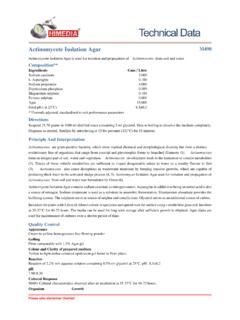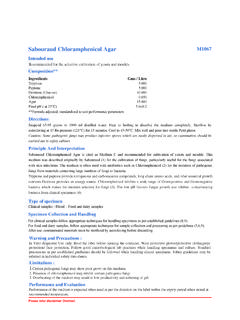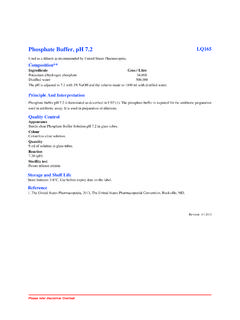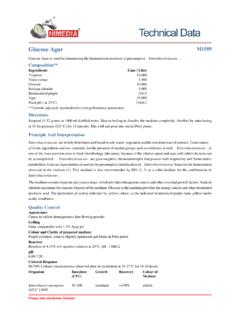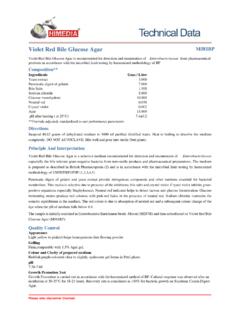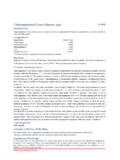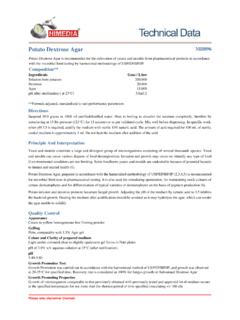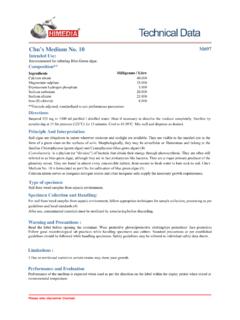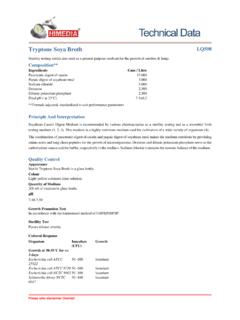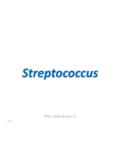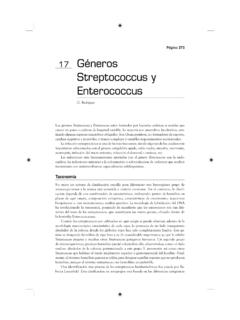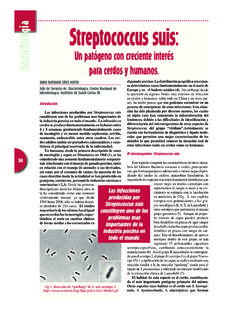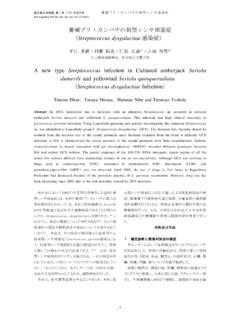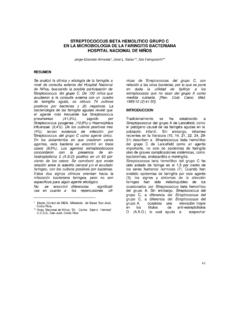Transcription of Edwards Medium Base, Modified M748 - HiMedia …
1 Please refer disclaimer Medium base , ModifiedM748 Edwards Medium base , Modified is a selective Medium for the rapid isolation of streptococcus agalactiae and otherstreptococci associated with mastitis and also from other clinical **IngredientsGms / LitrePeptic digest of animal pH ( at 25 C) **Formula adjusted, standardized to suit performance parametersDirectionsSuspend grams in 1000 ml distilled water. Heat to boiling to dissolve the Medium completely. Sterilize by autoclavingat D 115 C for 20 minutes. Cool to 50 C and aseptically add 5 to 7% v/v sterile sheep blood. Mix well and pour into sterilePetri plates.(D corresponds to 10lbs pressure)Principle And InterpretationStreptococci are gram-positive facultatively anaerobic bacteria, which constitute normal commensal flora of mouth, skin,intestine and upper respiratory tract of humans.
2 Group B Streptococci are an important cause of systemic infections in infantsand occasionally of bacterial endocarditis (1). Mastitis is a disease of cattle caused by the organisms streptococcus agalactiae. It belongs to the Lancefield group B Streptococci .The most common selective agents used for selective isolation of Streptococci are crystal violet and thallium salts. A selectivemedium containing crystal violet was used by Haxthausen to isolate skin Streptococci (2). Subsequently it was observed thatStreptococci from milk were able to grow on Gentian Violet Blood Agar whereas the other saprophytic milk bacteria wereinhibited on this Medium (3). An Esculin Blood Agar containing crystal violet was used by Edwards to isolate the causativeagent of mastitis (4).
3 A similar Medium containing thallous acetate was also used to isolate the causative agent of mastitis (5).Peptic digest of animal tissue and beef extract serve as sources of carbon, nitrogen and other essential nutrients. Esculin helps todifferentiate esculin-positive (group D Streptococci) organisms from esculin- negative ( S. agalactiae ) organisms. Sodiumchloride helps to maintain the osmotic equilibrium of the Medium . Crystal violet and thallous sulphate serve as the selectiveagents for Streptococci. Supplementation with blood provides additional nutrients in addition to serving as an indicator ofhaemolysis. Mastitis Streptococci show alpha, beta or gamma type of haemolysis.
4 Esculin differentiates esculin- positive groupD Streptococci (black colonies) from esculin-negative streptococcus agalactiae (blue to colourless colonies).Centrifuged test milk sample is directly inoculated on the surface of the Medium plate. Esculin-negative (blue to colourless)S. agalactiae organisms are further subcultured for identification ControlAppearanceCream to yellow homogeneous free flowing powderGellingFirm,comparable with Agar gelColour and Clarity of prepared mediumHiMedia LaboratoriesTechnical DataDisclaimer :User must ensure suitability of the product(s) in their application prior to use. Products conform solely to the information contained inthis and other related HiMedia publications.
5 The information contained in this publication is based on our research and developmentwork and is to the best of our knowledge true and accurate. HiMedia Laboratories Pvt Ltd reserves the right to make changes tospecifications and information related to the products at any time. Products are not intended for human or animal or therapeutic use butfor laboratory,diagnostic, research or further manufacturing use only, unless otherwise specified. Statements contained herein should notbe considered as a warranty of any kind, expressed or implied, and no liability is accepted for infringement of any Laboratories Pvt. Ltd. A-516,Swastik Disha Business Park,Via Vadhani Ind. Est., LBS Marg, Mumbai-400086, India.
6 Customer care No.: 022-61471919 Email: Website: Medium :Amber coloured, clear to slightly opalescent gel. After addition of 5-7% v/v sterile defibrinated sheep blood :Cherry red coloured opaque gel forms in Petri platesReactionReaction of w/v aqueous solution at 25 C. pH : ResponseCultural characteristics observed with added 5-7%v/v sterile defibrinated sheep blood after an incubation at 35-37 C for24-48 hours .Cultural ResponseOrganismInoculum(CFU)GrowthRecov eryColour ofColonyCultural ResponseEnterococcus faecalis ATCC2921250-100good-luxuriant>=50%blackE scherichia coli ATCC25922>=10 inhibited0%Staphylococcus aureusATCC 25923>=10 inhibited0% streptococcus agalactiaeATCC 1381350-100good-luxuriant>=50%colourless , w/haemolysisStorage and Shelf LifeStore below 30 C in tightly closed container and the prepared Medium at 2 - 8 C.
7 Use before expiry date on the Cruickshank R., Duguid J. P., Marmion B. P. , Swain R. H. A., (Eds.), 1975, Medical Microbiology, The Practice of MedicalMicrobiology , 12th Edition, Vol. II , Churchill Haxsthausen H., 1927, Ann. Derm. Suph., Bryan C. S., 1932, Am. J. Public Health, 22. Edwards S. J., 1933, J. Comp. Path. Therap., 46 McKenzie D. A., 1941, Vet. Rec., 53 : 1 / 2011
